Editor’s note: What happens when a car enthusiast in the US takes ownership of one Britain’s smallest but best-loved classics? Matt Fink, a writer with the Hagerty Media team in the US, reveals all…
Last year my dad and I went on a mission to buy a classic car together. While we definitely made some mistakes along the way, we ended up with a 1971 Mini Cooper Mark 3 Innocenti for $2500. So far, so straightforward. Yet we live in Columbus, in Ohio, America, where every other car on the road is as large as the typical two-up, two-down terraced house across the pond in Britain, making the Mini a peculiar site that’s somewhat out of its natural environment of London’s West End, to say the least.

And then there was the condition of the Mini. We couldn’t test drive it, or even see the engine. It was a car that hadn’t been driven in many years, and we were told needs $6000 in repairs just to get it running. Oh, and it’s rare enough if it were a Morris or Austin, but being the Innocenti version made things trickier still when it came to fixing it.
Based on feedback I have had from Hagerty Media readers over in the US, it seems we made a HUGE mistake taking that kind of risk on a 50-year-old British/Italian car. But did we?
My dad and I had four goals when getting into classic car ownership:
1. Have fun.
2. Make memories.
3. Learn how to fix some stuff.
4. Make money in the end.
Man, we were off to a rocky start.
(Yes, I am aware the fourth part of our plan goes against all the rules of car collecting and is also highly unrealistic. But what can I say? We have yet to learn our lesson.)
Admittedly, it was a big mistake to not consult a local club or internet forum for advice. Our solace came in the fact that I believed the car would still be worth more than $8500 – purchase price plus estimated repair costs. That said, I am having a hard time getting an accurate estimate of its worth since the Innocenti version appears to be rare enough that I can’t find any comparable sales.
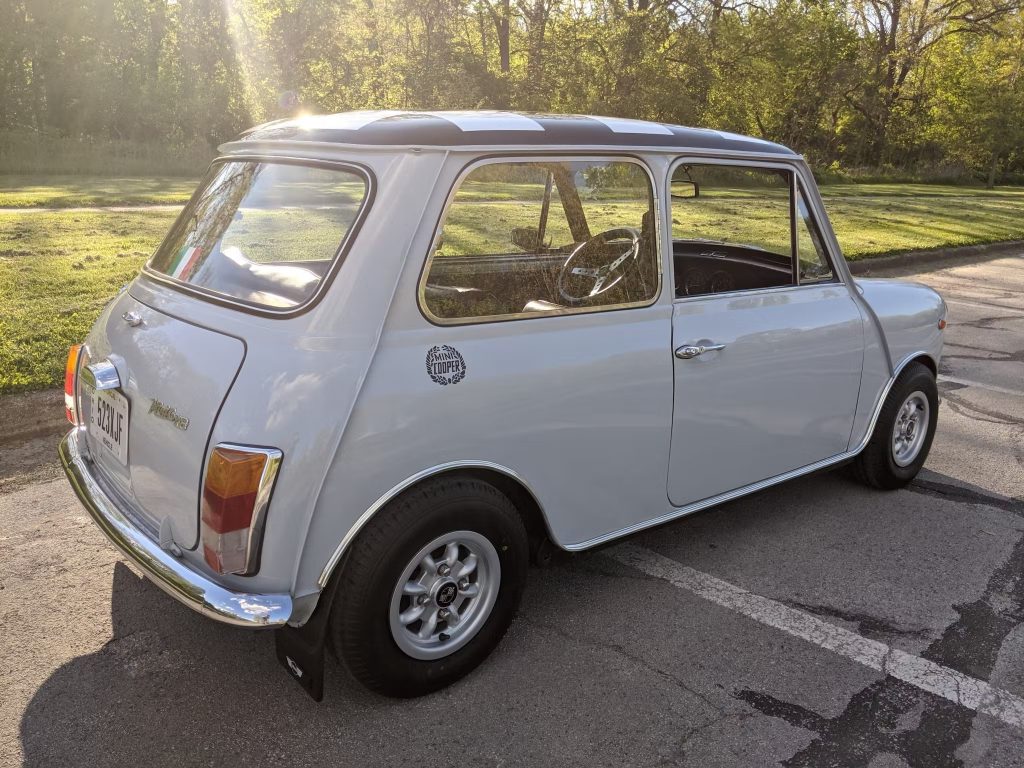
We set to work – and by “we,” I mean the someone else we paid. As much as I desired to learn how to work on cars with this project, a clutch replacement did not seem like a wise starting point. I (correctly) assumed if we could just pay someone to get the car running, there would be plenty of other jobs to come. Here is where we are financially:
$2500 purchase (plus $100 tow and $300 inspection)
$1803 parts (battery, fuel pump, clutch, master cylinder, slave cylinder, front axle u-joints, alternator, and tax)
$3931 labour (installing all those parts plus coolant flush, brake fluid flush, install tires, tune up, drain and clean original fuel tank, clean carburettor, and an oil change)
$298 new tyres (10-inch Yokohama tyres from England)
= $8932 total invested
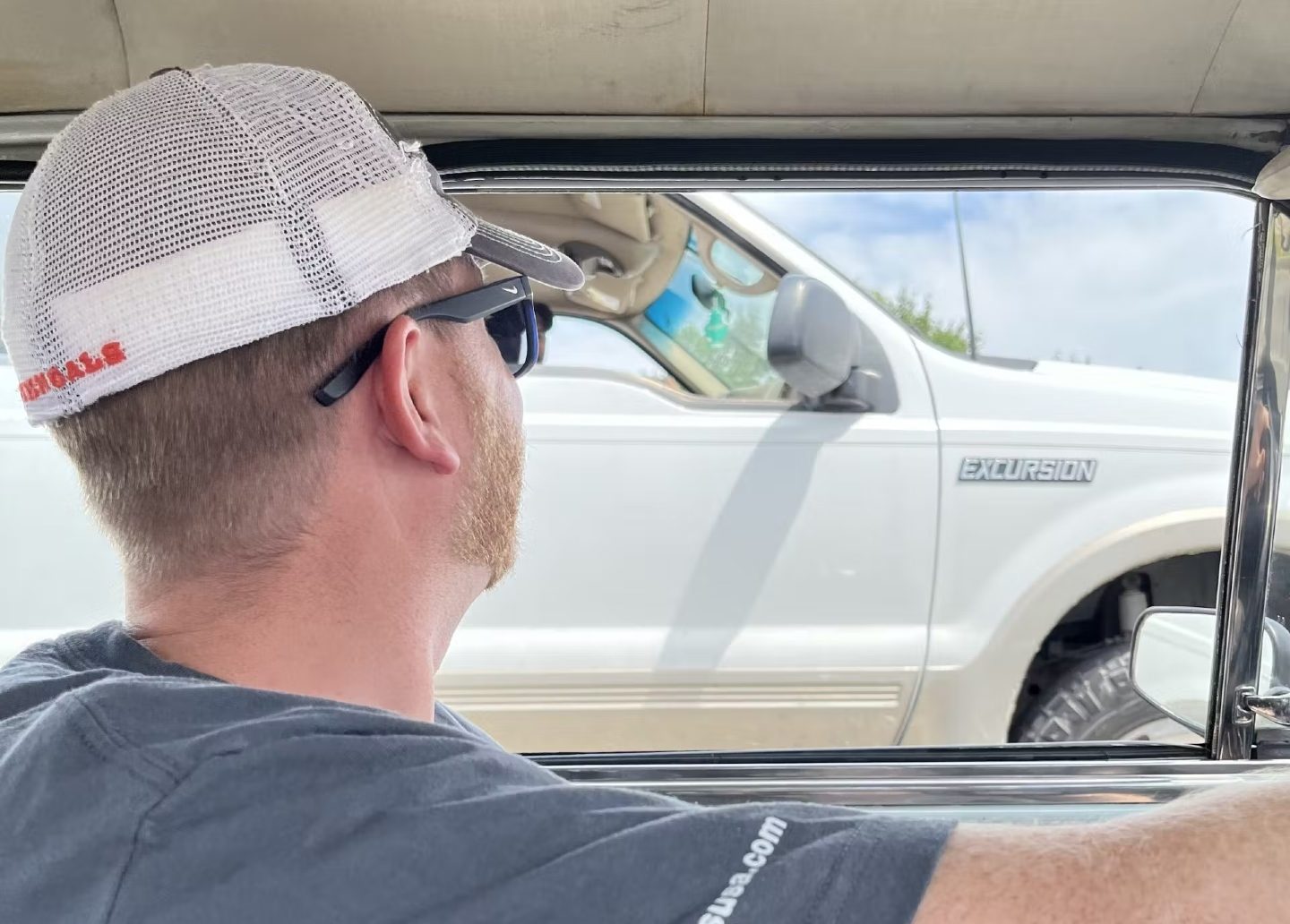
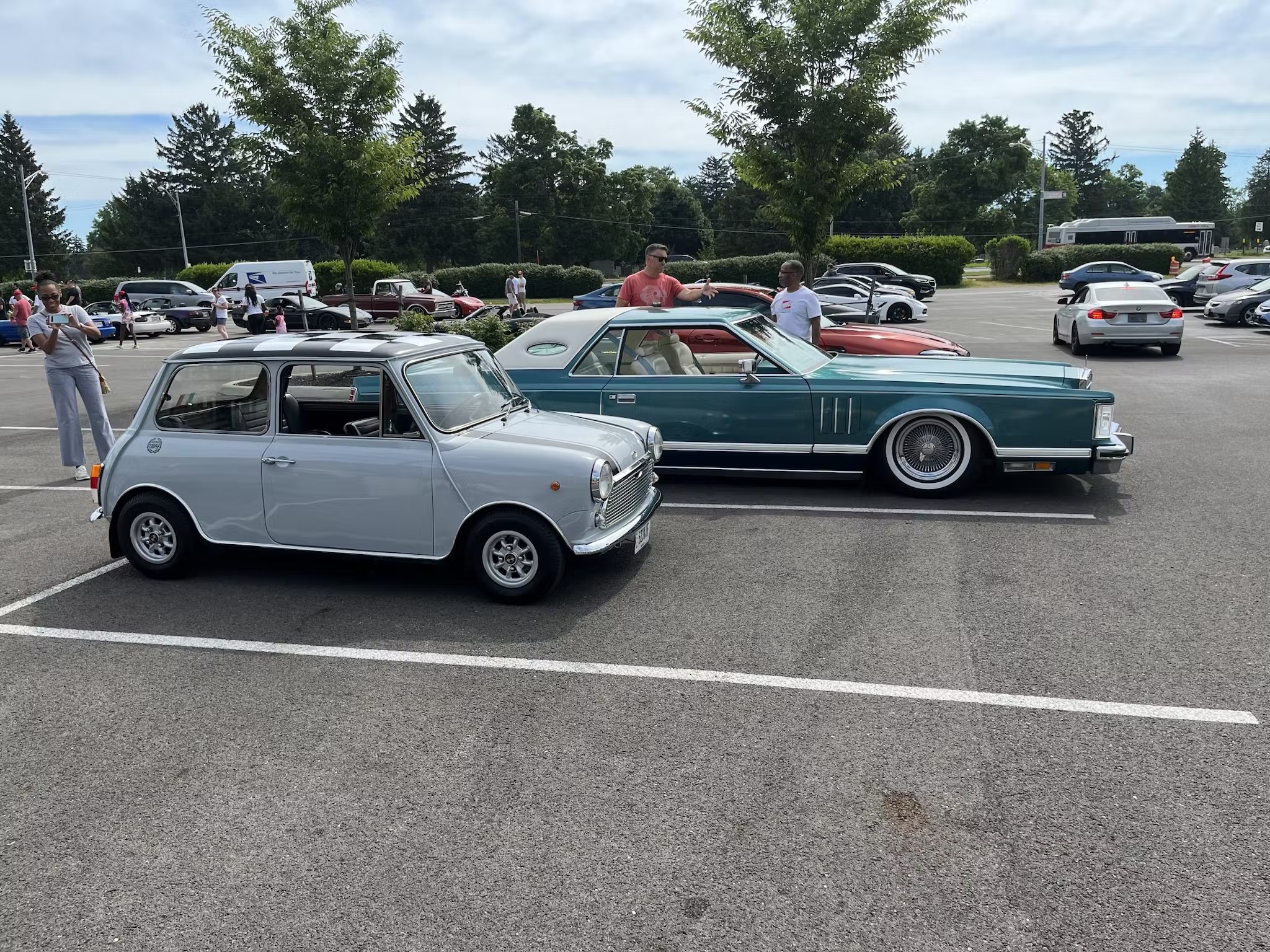
Six weeks later and we finally had a driving classic car… that still needed a lot of work and was of indeterminate value. The first drive home with my 12-year-old by my side was MAGICAL. We literally lost count of how many cars beeped and waved, the smiles it brought to other’s faces, and the number of people (not just my mom, I promise!) that took pictures of us on that 20-minute jaunt.
Far and away, that is my biggest surprise in owning a classic car, particularly a classic Mini Cooper – the attention it creates and the joy it brings to others. Which brings me to my first Biggest Surprise of Classic Car Ownership.
The value of the car has nothing to do with the impact it has on people around you
I can’t go anywhere without being stopped to talk about the car. We found a local Mini club where they told me to plan an extra 5 or 10 minutes when going somewhere to have time to answer stranger’s questions about the car. The first-time riding in the car with my dad, we were passed by a McLaren 720S in full race livery, which went unnoticed by the family of four in the Accord in front of us. However, when I pulled alongside to pass the family sedan (which was a huge accomplishment in itself!), there were kids literally hanging out of the windows waving, grabbing their parent’s phones trying to get a video, and even the parents beeping and speeding up to get a good look. Despite the $300,000+ difference in price, we were the ones that received all the attention.
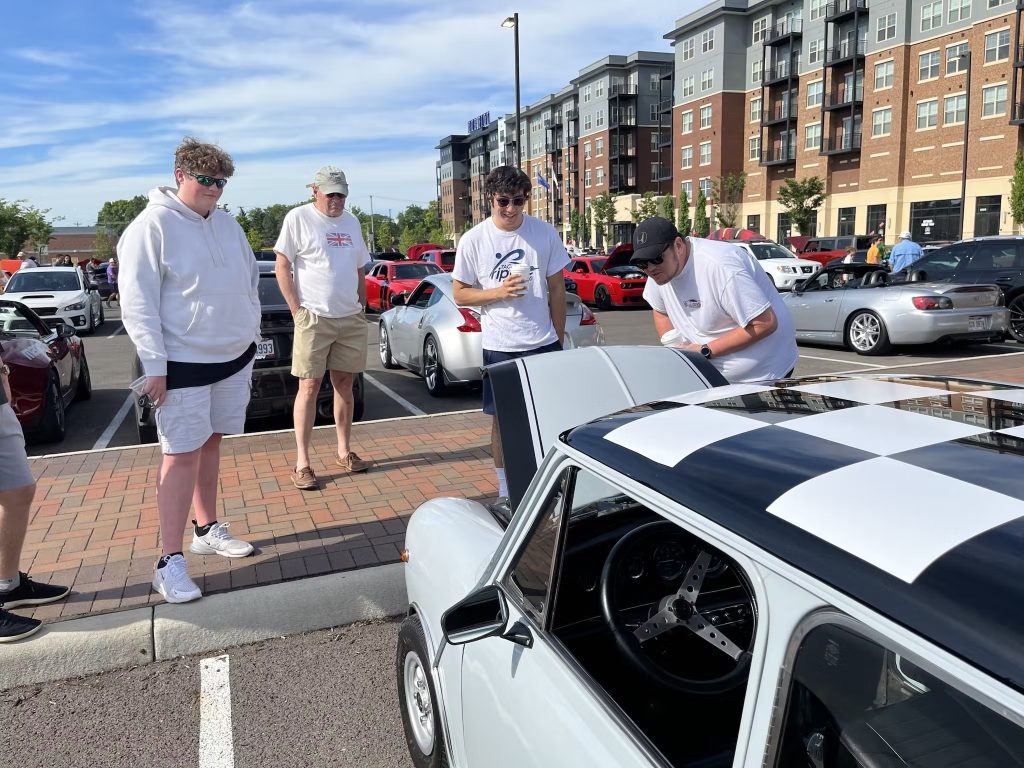
There is just something about driving a small car in a land of giants that creates excitement and feelings in others that they themselves can’t quite understand. It causes people to lean out of moving cars to try to film us driving by, to follow me across town just to get a picture of themselves with the car (this has happened twice so far), and countless more to beep and wave with the biggest smile on their face. My oldest son and I have a running count of the number of times we have taken the Mini out when someone has NOT attempted to get our attention just to smile and wave. We are currently at two.
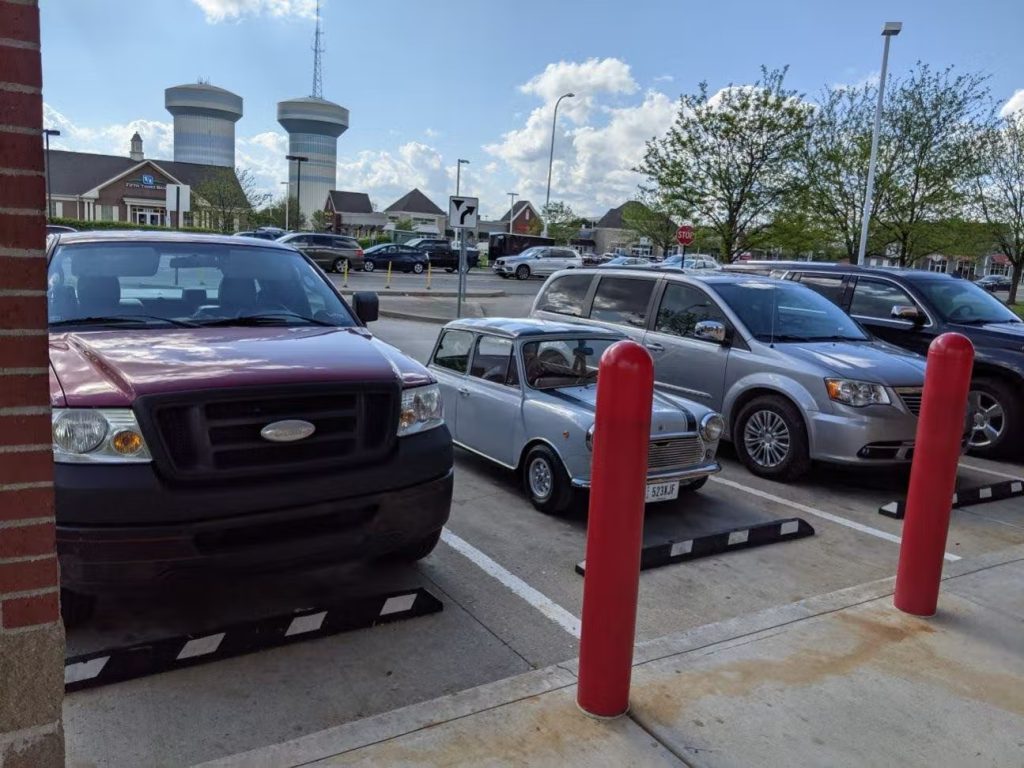
Classic cars have some, um, unique features
There have been many a book and magazine dedicated to the Mini and the impact it had on the world of automobiles. As I’ve only owned mine for a year, I’m no expert, but I will share a few of the more interesting things about it.
The inventor, Sir Alec Issigonis, found music to be unnecessary so he designed the car with no radio (it wasn’t until years later that it became an option). However, he was a smoker and apparently found that necessary, as he insisted every seat had easy access to an ashtray.
The firewall is made of horsehair.
My car is 51 years old, but if you had bought one in 2000 (before the BMW version), it would basically look the same as the other 5.3 million produced since 1960. For 41 years it went through no major changes, which is unheard of today.
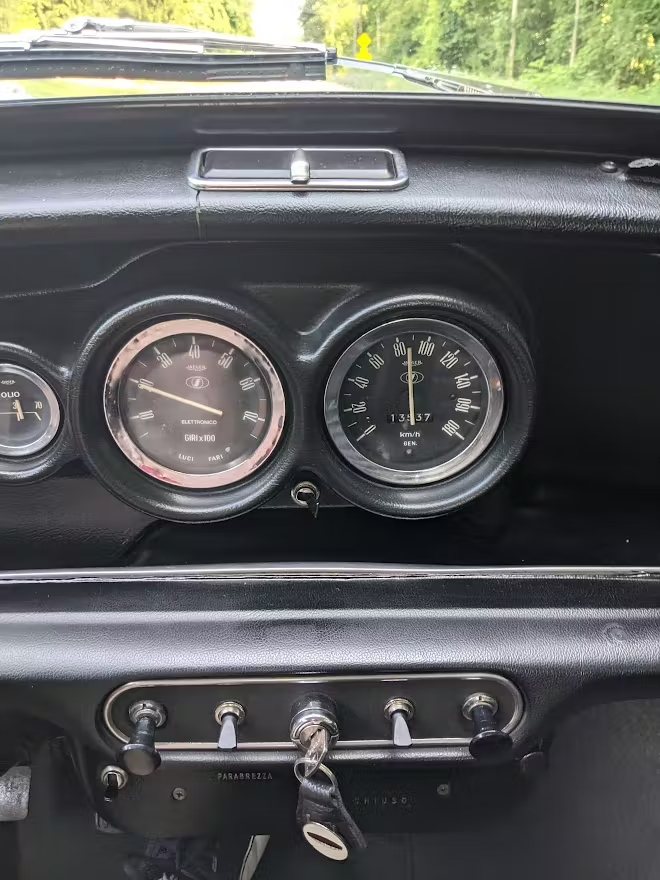
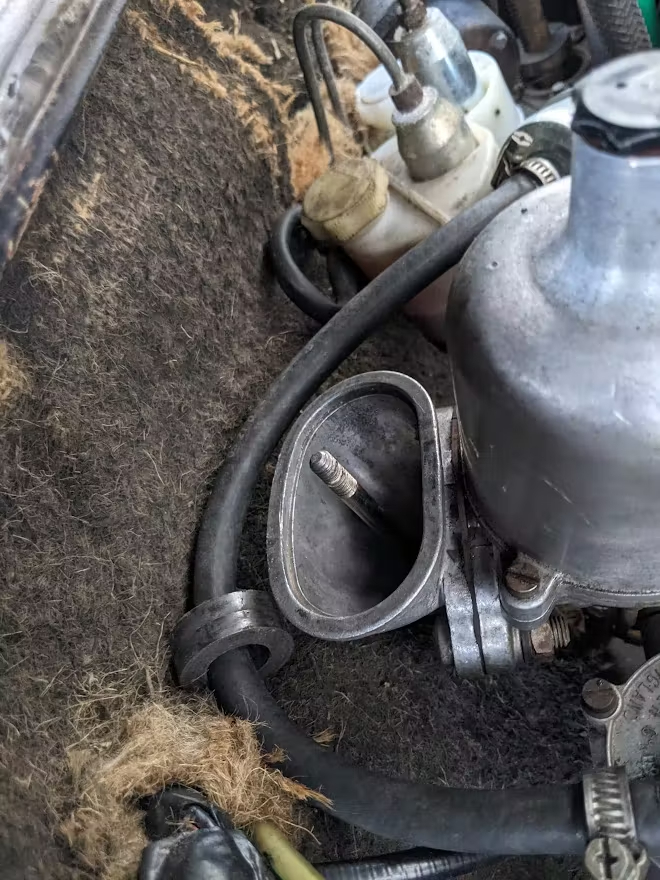
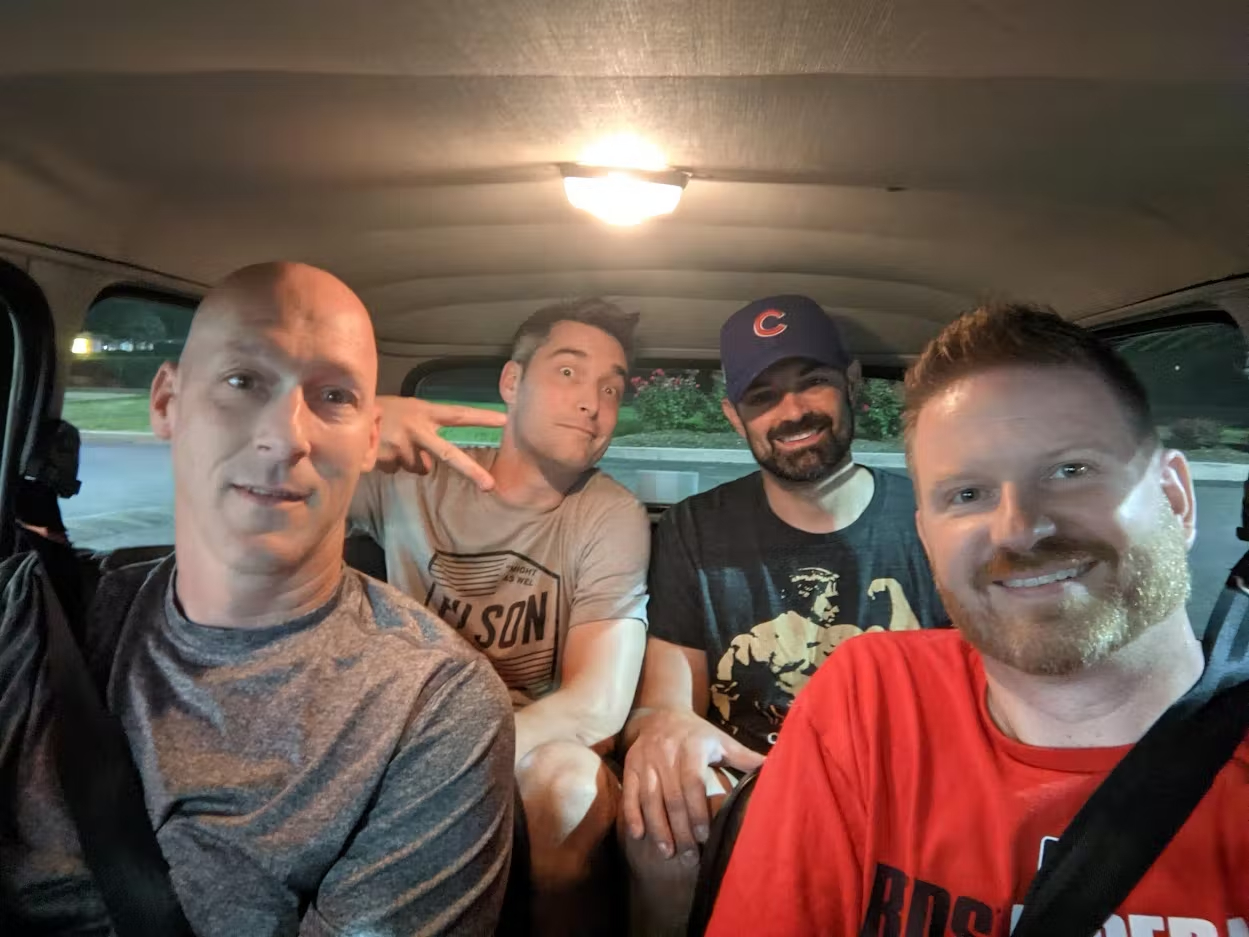
The Mini is a packaging miracle, as evidenced by the head and leg room demonstrated (above) by me and three other 6-foot friends comfortably going out for a ride. This was accomplished by putting the wheels at the very corners of the 10-foot x 5-foot body with virtually no overhang and turning the engine sideways to save space. This is the car that helped popularise front-wheel drive. The gearbox and transmission were put under the engine and shared the same oil. You know what other car had an engine and transmission setup like that? The Lamborghini Miura, baby. So, basically same same. Putting the powertrain sideways allows big Americans to fit in just fine. Thanks, Sir Alec!
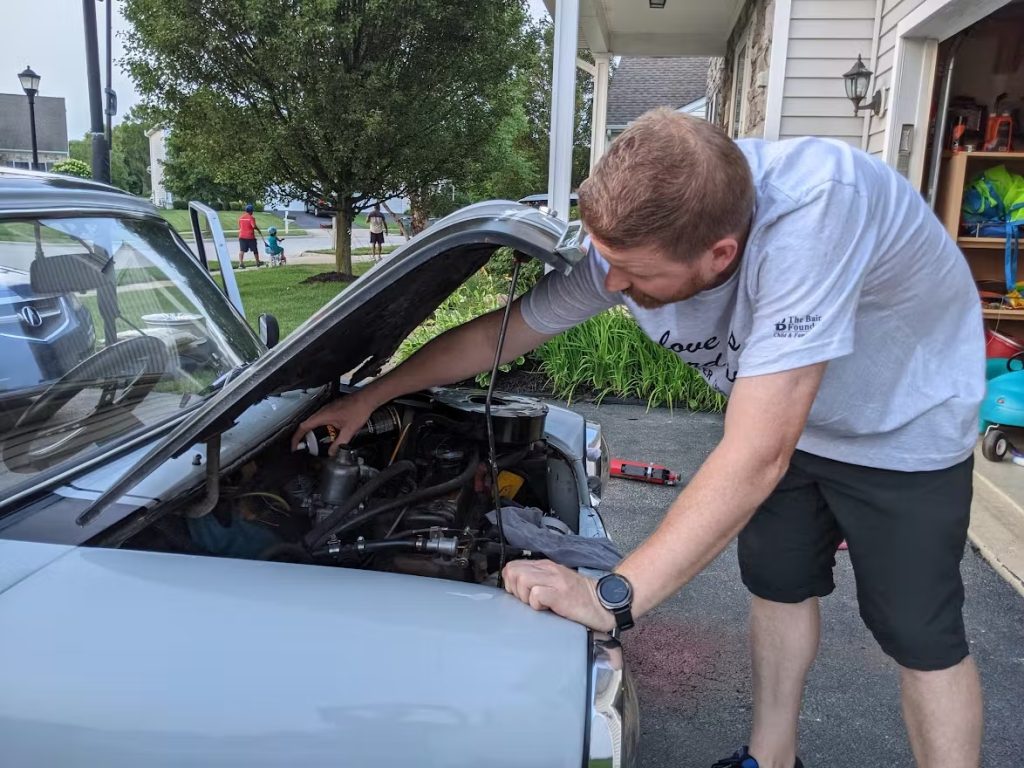
Watch your head when working on it! For some reason the hood only opens to about a 45-degree angle, meaning everyone who has a classic mini also has a sore back.
It has parts that I’ve never even heard of, like a water bag, hydrolastic suspension, and a dash pot.
Classic cars are slow (at least this one is)
Our Mini weighs in at just over 1400 pounds (about 640kg), and I found the 998cc motor (which was the BIG motor option, by the way) produced 46 horsepower when new – though I’m confident many of those Italian-bred horses stayed behind at the pasta bar. It’s hard to get an accurate 0-60mph time, but my best-timed version was 51 seconds. Not joking. I can get 0–50 mph in 29 seconds, but there just isn’t much oomph left to go from 50–60 mph. In college, I drove a 1991 Honda CRX HF with a 1493cc motor and 62hp that could manage 0-60 in 14 seconds. It was basically a Bugatti compared to the Mini.
The original designers thought 1000cc was going to be too fast for motorists, so the engine was reduced to 850cc, which helped the car reach 60 mph in a blistering 26.5 seconds in 1960. Imagine how quickly an engineer would be kicked out of a meeting if they said that now! Having always heard about the Mini’s racing pedigree and rally wins, I was a little surprised at the huge difference in speed compared to a modern car.
Despite the lack of thrilling acceleration, I do love driving it. With a wheel practically at each corner, it gives you great road holding. In the same way that when riding a motorcycle you notice every crack in the road and change in elevation, the Mini makes you feel everything. Shifts are planned out based on the slightest incline of the road approaching. Routes are decided based on avoiding the biggest hills.
The work never seems to end
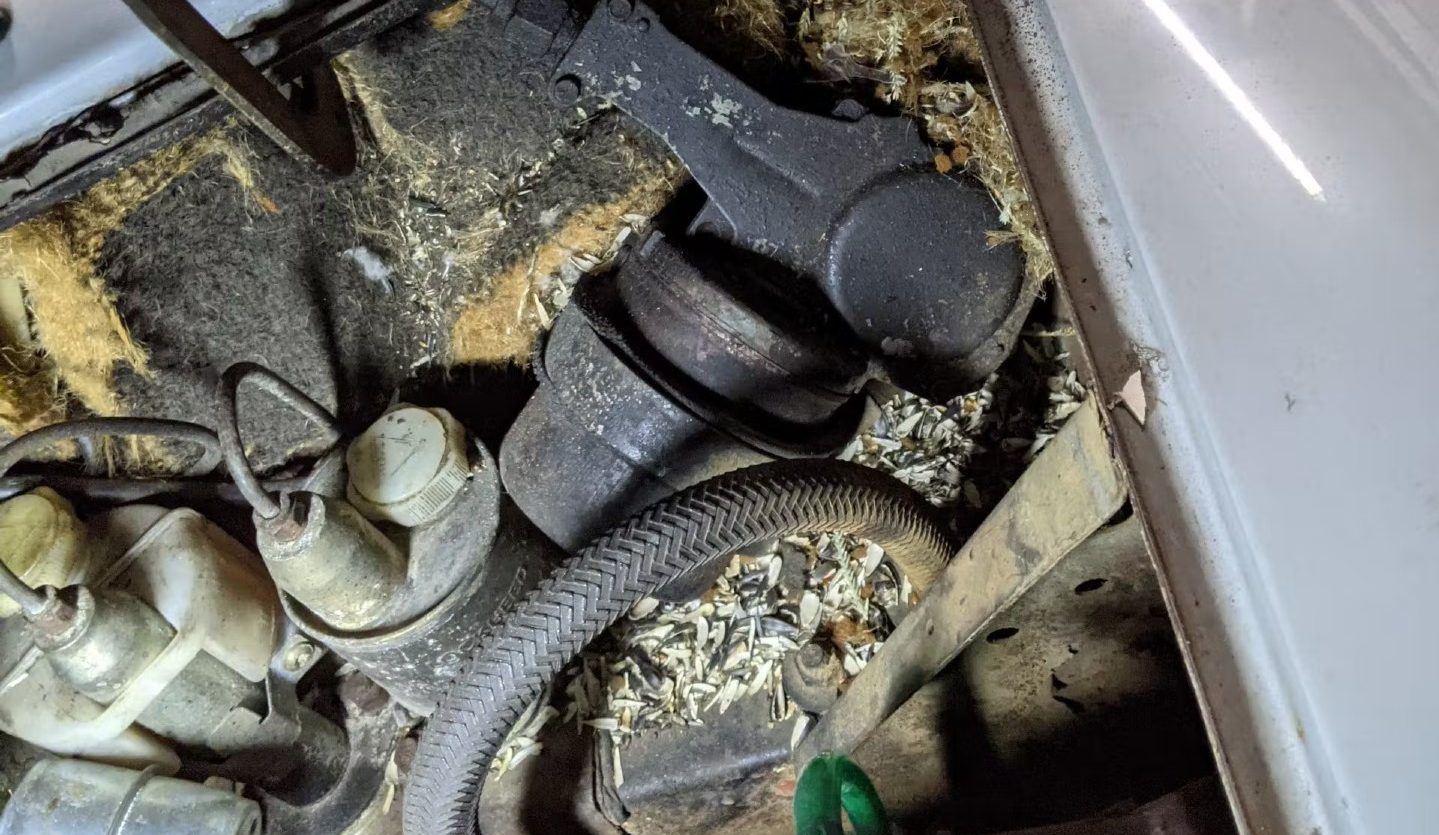
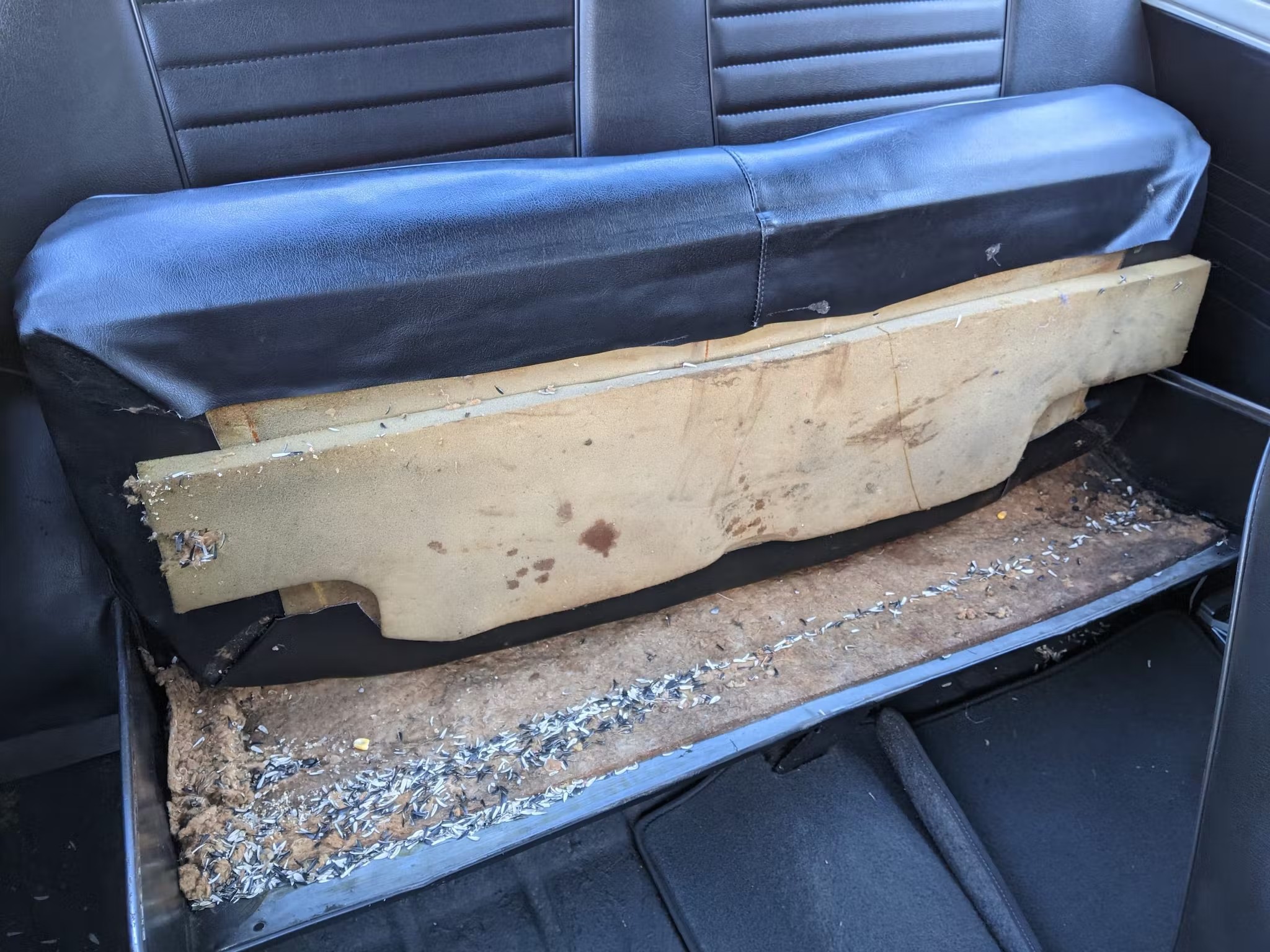
Buying a 50-year old car out of a barn that was filled with sunflower seeds meant the list of required cosmetic work was extensive. First thing, removing all sunflower seeds has proven to be harder than you’d think. They. Were. Everywhere. Every nook and cranny, under every cushion, throughout the engine bay, stuffed in the air cleaner, and throughout the ventilation system. Each time I thought I‘d got them all, I’d move something and tons more would spill out. Turning on the air vents literally resulted in us getting pelted in the face with seeds. I felt like we were in a cartoon! Now, a year later, if I hit a bump hard enough a couple seeds will fall out from somewhere. At this point I just laugh and enjoy the unique conversation starter it provides. Thankfully, it was only sunflower seeds and not rodent poop or chewed wires. It seems that a chipmunk had been using the Mini as a pantry to store sunflower seeds for years.
The paint needed correction, but not to the point of wet sanding. So, I grabbed a couple of my kids and we washed, clay barred, compounded, polished with an orbital buffer, and waxed away. All the chrome inside and out needed work (there is, surprisingly, a large amount of chrome on the interior). The leather needed to be cleaned and conditioned, and on and on.
My dad turns 80 this year, but he still got in there a couple times and helped to bring the chrome back to life and spent a long day working on the rust. We found a few little pin holes, but thankfully nothing major. Hours of sanding and treating and coating the floorboards has our Mini looking better and hopefully stopped any rust progression, but it is not restored by any means. I don’t want a concours-level car. I want a car I can drive and my kids can help with without fear of damaging something priceless.
It’s been great seeing the younger generation get involved in helping, or at least always asking for a ride in the car. My 5-year-old son loves using the jack to help rotate tyres. My oldest son enjoys helping with the actual repairs. We may not know much, but we are learning.
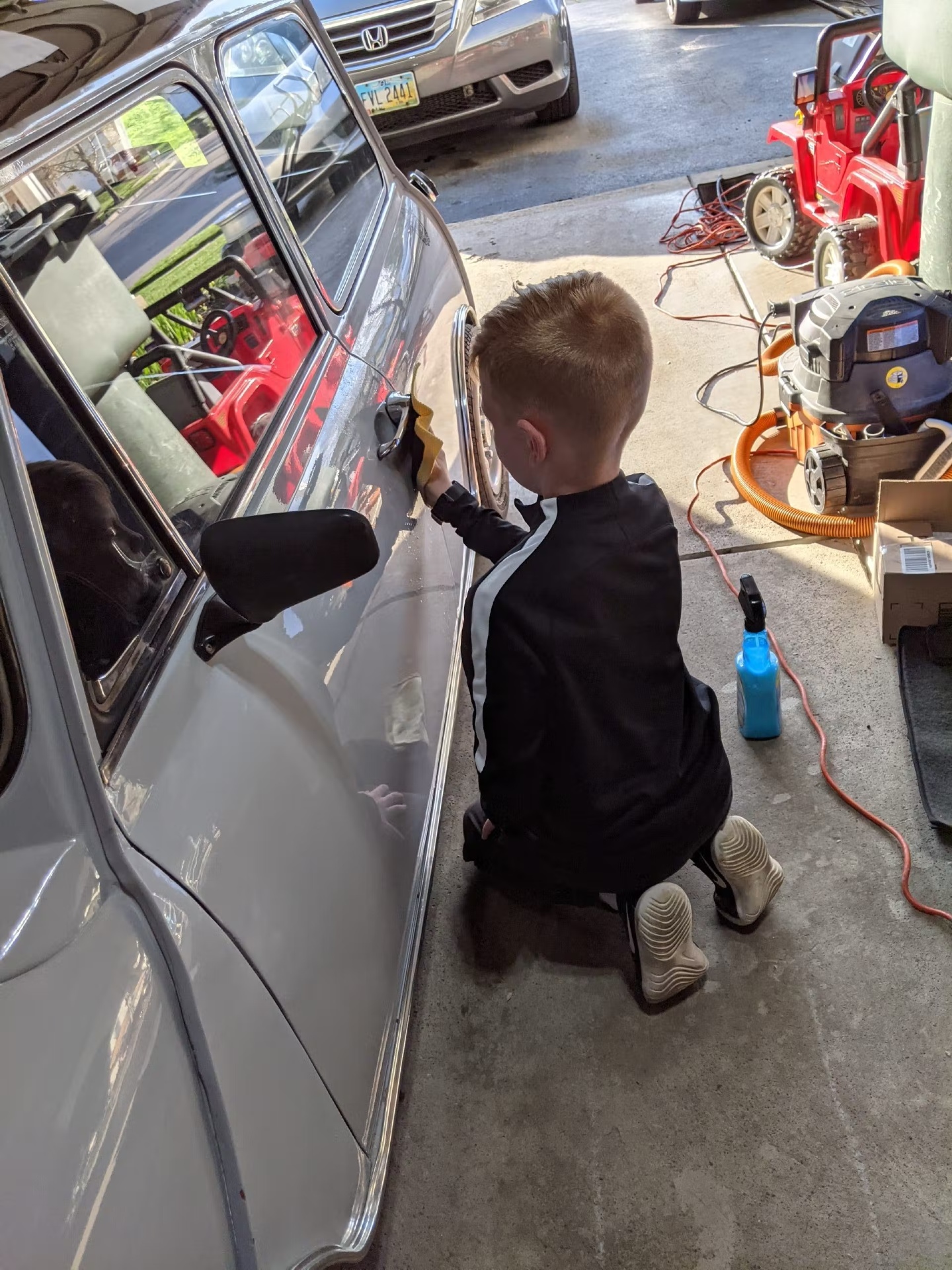
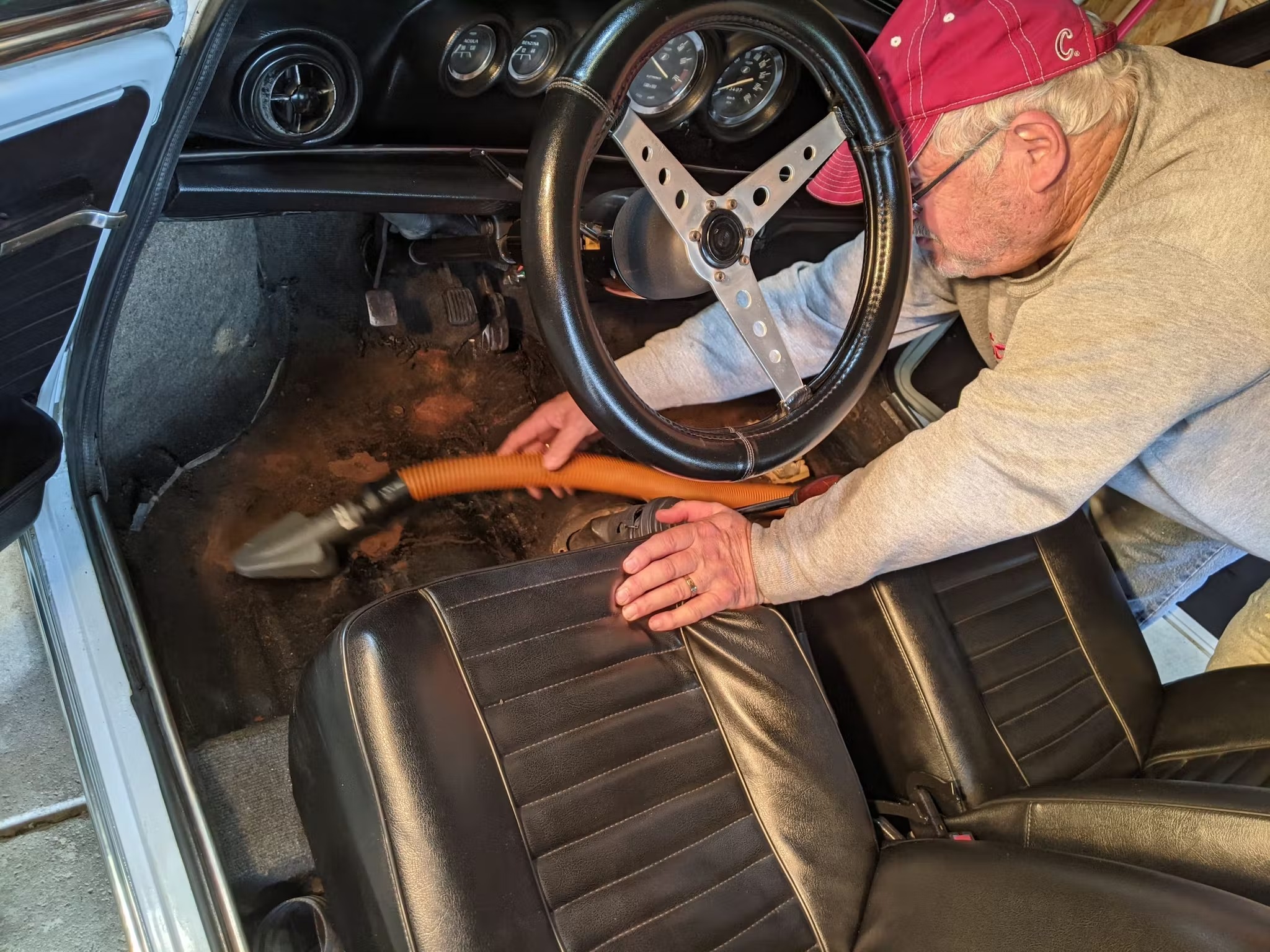
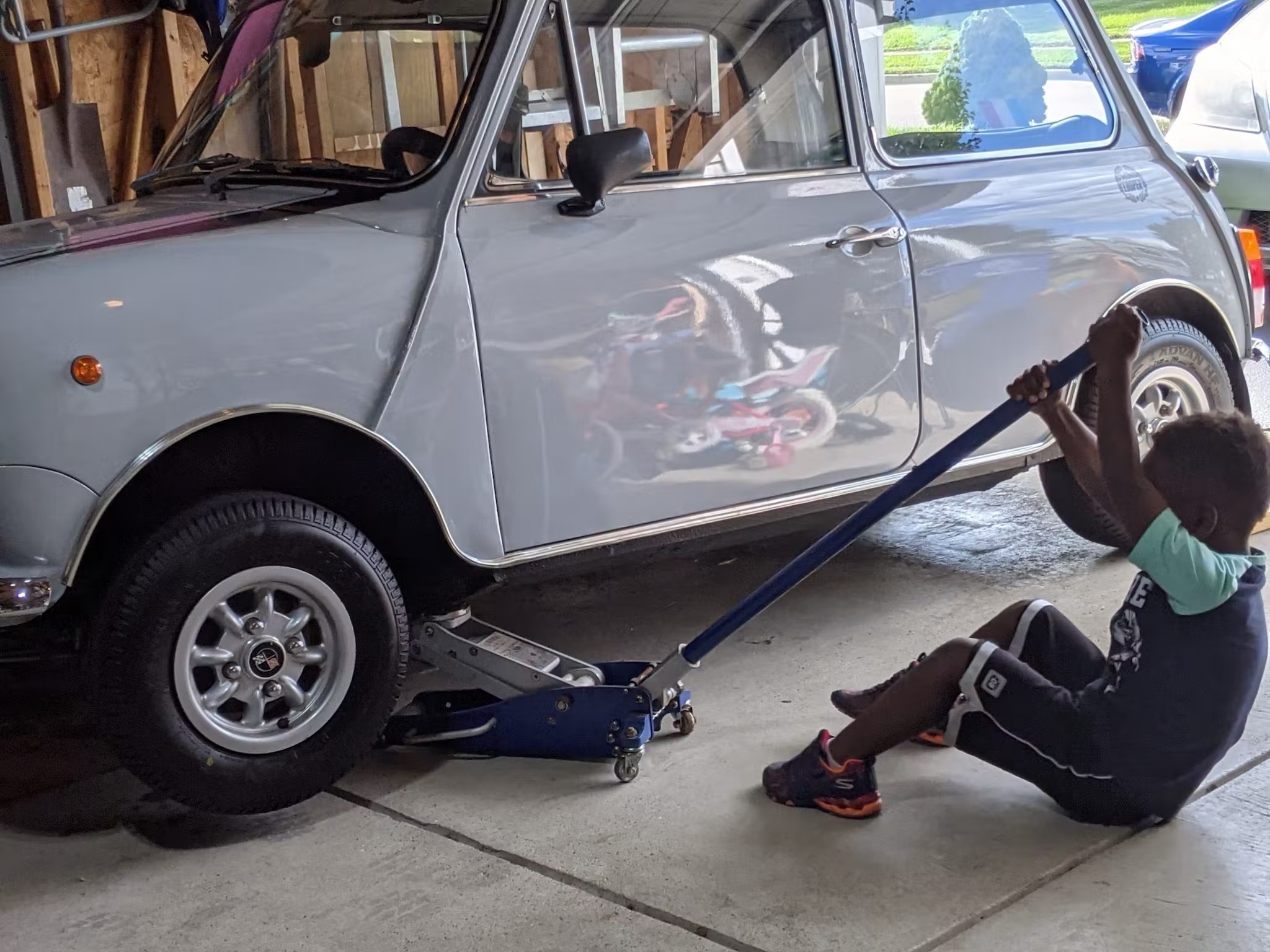
The car has a miniscule five-gallon fuel tank, and I ran it too low one day, which dislodged some gunk from the bottom of the original tank. It took me weeks to diagnose why it wouldn’t run. Once I figured out the problem, I was able to purchase some new fuel lines and fuel filters. When I knew I was on the right track, I stayed up until 2am to see this repair through. Having the Mini start right up and run after fixing a problem all on my own was one of the best automotive feelings I’ve ever had.
I’m starting to get it now: Fixing your car yourself is addicting! My struggle is that every YouTube video I find doesn’t look like my car. If could do it over again, I would not go for the rare Italian-built version. I really wish my engine bay looked like everyone else’s, thus making my repair attempts a lot easier. Over the last year I’ve learned how to adjust a carburettor, set idol speeds, replace fuel lines and fuel filters, clean the distributor, replace the air cleaner, and repair rust, as well as how to downshift without synchromesh, and even how to read a handful of words in Italian. One thing I didn’t learn was how to tell how fast I’m going in kilometres-per-hour, as I still resort to having my son hold up my phone while I use a speedometer app.
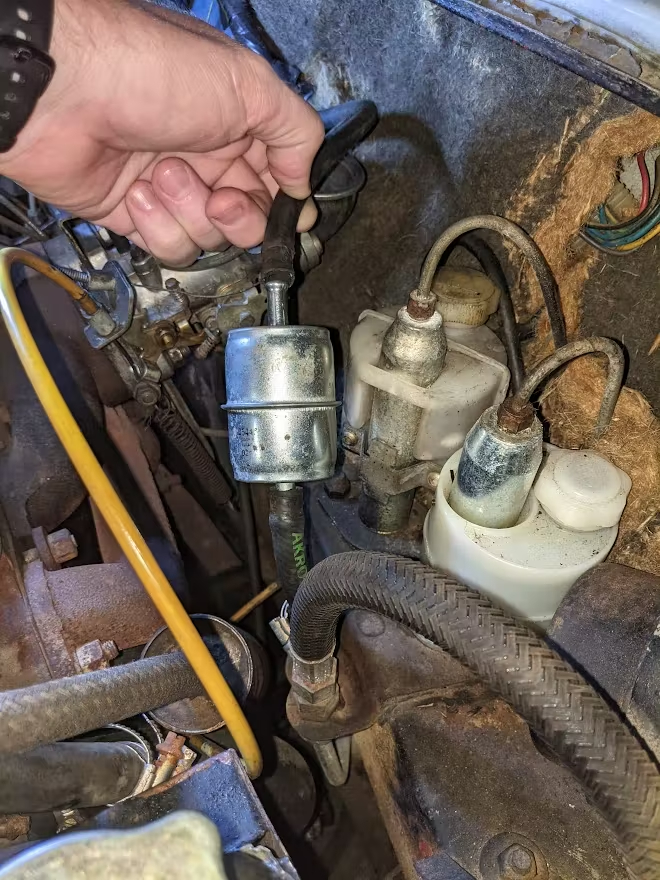
Something I’ve come to realise is most classic car owners work on their cars themselves. This isn’t necessarily a surprise, however when I needed to find a mechanic to help with an oil leak I was having, no one in the local Mini club (and I asked a lot of people) even had a mechanic they’ve used. Like at all. They all do everything themselves.
Everyone has an opinion about your car
The first thing every “non” car person asks is, “Is this a real car?”
The first thing every “car” person asks is, “What year is it, and what size are those wheels?”
The first thing every “Mini” person asks is, “Have you thought about adding dual carbs, flaring the wheel arches, and going up to 12-inch wheels?”
We learned early on that it seems like the car is mostly original. So despite everyone telling us how we can make it faster, we decided to keep it stock. With it being the rare Italian version, that seemed like a better decision for the long run. Sorry, I will not be making it into a Cooper S replica. I do love the conversations it creates, especially from people who normally couldn’t care less about cars.
I’ve gotten attached to it, and I don’t want to sell it, but …
Driving my son and dad to a Cars and Coffee event that we actually got to participate in was literally something I’d dreamed about. A crowd quickly formed around the Mini, and my son and I walked away to let my dad be the centre of attention, telling stories about the Mini (some of which were true). Even if we end up losing money when we sell it, that moment was worth it all. I should have been better at taking it to car shows; it’s so much more fun that I anticipated. The regret is already growing that I didn’t drive it more – and we haven’t even sold it yet.
Can it be used as a daily driver? Well, there is no air conditioning, only sort-of heat, as good as no safety equipment, and in the Mini’s case, no radio, let alone infotainment system. Surprisingly, mine is also bad on fuel economy, requires premium fuel, and is really slow. Although I have driven it to work, making this a daily driver is not an option.
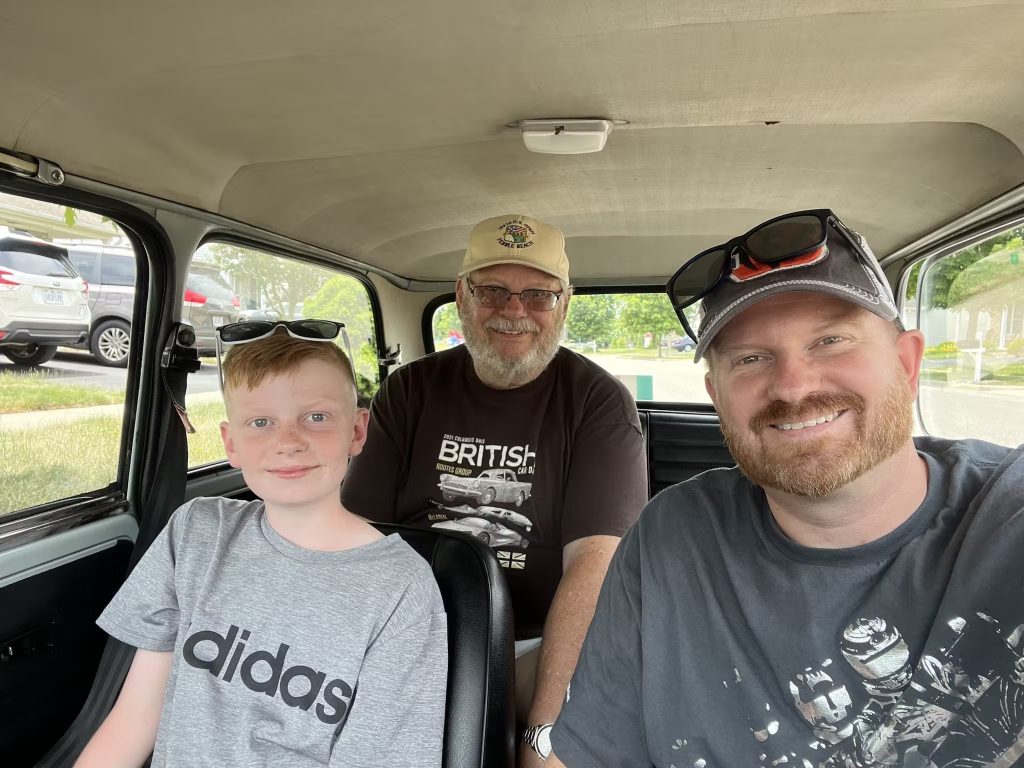
Over the last year we’ve only had to take it back to the shop once when the headlight switch burnt up and I wasn’t able to figure out the wiring repair needed. That added $280 to our total, putting us at an all in of $9212. For that price we have a roadworthy automotive legend, though admittedly it is not perfect. The tach and fuel gauge don’t work, and the turn signal stalk snapped off in my hand (50-year-old plastic). I’m trying to decide if it’s worth sorting those before we sell it.
Now that you know all this, did we buy it right? Or pay too much? Let me know in the comments. Let’s check our goals to date:
Have fun = check!
Make memories = check!
Learn how to fix some stuff on a car = check!
Do all of this, and still make money… = TBD
I’ll write an update soon about how the sale goes and if we were, in fact, able to make a profit. And if anyone has an idea of the value of the Innocenti version, let me know. In the meantime, I’m going to reach out to the original owner and see if he’d like one more ride before it sells. I have absolutely loved my first year of classic car ownership.
Read more
We fell out of love but I’ll stick with my Mini Marcos to the bitter end
Total rebuild of classic Mini Cooper S engine time-lapse | Redline Rebuild
Review: The David Brown Mini Remastered Oselli Edition is a miniature marvel









Hi If your Mini Cooper is really a Cooper it should have twin carbs. though I understand the Block and Crank were standard mini on the Italian produced cars ..the head was configured as the Cooper spec.. performance will be in the region of 0-60 in 14 secs top speed approx 90 mph fuel consumption 25-30 mpg (UKmiles) These little cars went like stink ( see the film “The Italian Job ” )
if you have crash gear changes I suspect that the syncro hubs are very worn as this box had full syncro when new. The syncros wear very quickly if oil and filter changes are not frequent .
You’ve got the bug haven’t you! Over in the UK I’ve owned 3 and driven a lot more,and they are so much fun on our back roads.All 3 were written off- the 2 racers in accidents,and the road car with rust,but somebody built a racer out of all the bits! It sounds as if your engine is down on compression,it might be worth lifting the head to look for gasket or valve damage,the old engines hate unleaded fuel-it wrecks the valve seats! And don’t what some idiot on a U TUBE link did on here and try and lift the engine with the rocker studs,unless you want it on your feet. The gasket is a 15 minute if know what you are doing,we did on the racers in the middle of a field. Keep at it,those Italian jobs are rare.
A true Miniac will not sell a Mini, Just buy another one… or two.
Keep the little dear, convince yourself it’s an investment and eventually pass it on to your kids.
If you do sell it, you’ll be looking for another one within a year, guaranteed.